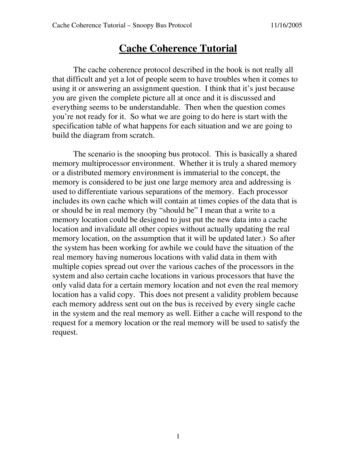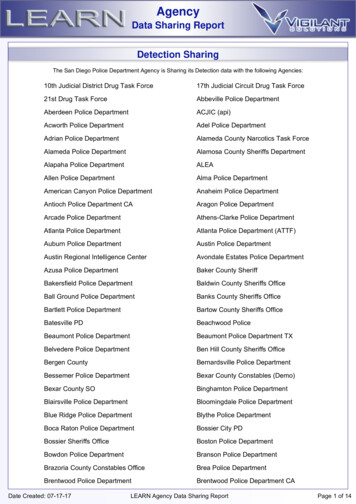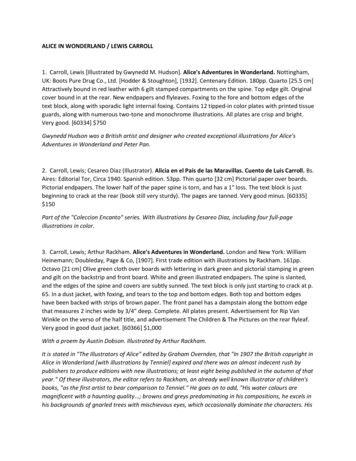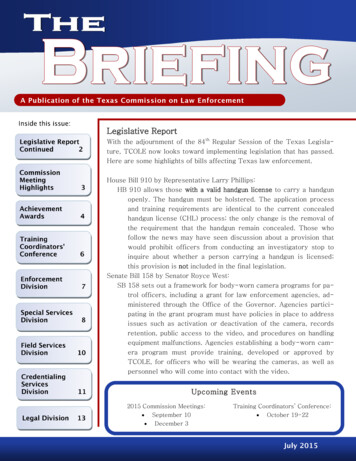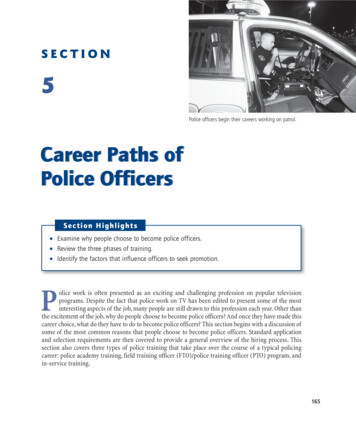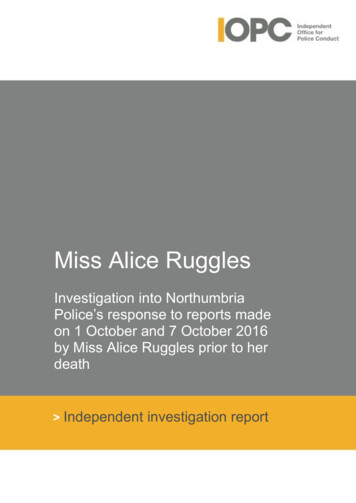
Transcription
Miss Alice RugglesInvestigation into NorthumbriaPolice’s response to reports madeon 1 October and 7 October 2016by Miss Alice Ruggles prior to herdeath Independent investigation reportAlice Ruggles – Final report for publication (redacted)1
Investigation informationInvestigation name:Alice RugglesIOPC1 reference:2017/091096Investigation type:ConductIOPC office:WakefieldLead investigator:Jessica KenyonCase supervisor:Gareth JonesDirector General delegate(Decision maker):Ian TolanStatus of report:FinalDate finalised:6 June 2018On 8 January 2018, the Independent Police Complaints Commission (IPCC) became theIndependent Office for Police Conduct (IOPC). We have referred to ourselves as the IOPC within thisreport.21
Contents Introduction . 4 The investigation . 6 Subjects of the investigation . 6 Policies, procedures and legislation considered . 8 Summary and analysis of the evidence . 15 Next steps . 38Appendix 1: The role of the IOPC . 413
Introduction The purpose of this report1.I was appointed by the IOPC to carry out an independent investigation intoNorthumbria Police’s response to telephone calls made to them by MissRuggles on 1 October and 7 October 2016. On 12 October 2016, Mr TrimaanDhillon killed Miss Ruggles at her home in Gateshead and was convicted of hermurder on 26 April 2017.2.This is my report for the Director General (DG) delegate, who I will refer to asthe decision maker for the remainder of this report. I will aim to: provide an accurate summary of the evidence and attach or refer to anyrelevant documents provide the decision maker with sufficient information based on which theywill be able to determine whether any person serving with the police has acase to answer for misconduct or gross misconduct, or no case to answer,or whether any such person’s performance was unsatisfactory provide the decision maker with sufficient information based on which theywill be able to determine whether disciplinary proceedings should bebrought against any person to whose conduct the investigation related,and the form of any such proceedings provide the decision maker with sufficient information about whether theyshould refer any matter to the Crown Prosecution Service (CPS) provide the decision maker with sufficient information based on which theywill be able to decide whether to make a recommendation to anyorganisation about any lessons which may need to be learned3.For the purposes of reaching determinations following receipt of this report, thepowers and obligations of the director general have been delegated to thedecision maker, Operations Manager, Ian Tolan.4.On receipt of the report, the decision maker will form an opinion2 about whetherany person serving with the police has a case to answer for misconduct or grossmisconduct (or no case to answer), whether their performance wasunsatisfactory, and any other matters dealt with in the report.5.The IOPC will then send a copy of this report and the decision maker’s opinionto Northumbria Police. Northumbria Police must advise the decision maker whataction, if any, it will take in response to it. If the decision maker does not agreeThe legislation that sets out what information needs to be included in an investigation report haschanged. There is no longer a requirement for the investigator to give their opinion on whether anysubject of the investigation has a case to answer for misconduct or gross misconduct or no case toanswer within the report. Instead, the delegated decision maker will give their opinion on a separateopinion document.2Alice Ruggles – Final report for publication (redacted)4
with Northumbria Police, he may make recommendations and ultimatelydirections for any further actions or determinations. The decision maker will alsodecide whether to make a referral to the CPS.6.Where article 2 or 3 of the European Convention on Human Rights (ECHR) isengaged, this investigation is also intended to assist in fulfilling the state’sinvestigative obligation by ensuring as far as possible that the investigation isindependent, effective, open and prompt, and that the full facts are brought tolight and any lessons are learned. Background7.Miss Alice Ruggles was murdered on 12 October 2016 at her home inGateshead by her ex-partner, Mr Trimaan Dhillon, known as Harry Dhillon.8.Miss Ruggles had telephoned Northumbria Police twice prior to her death, onceon 1 October and again on 7 October, to report unwanted contact from MrDhillon. As such, Northumbria Police referred Miss Ruggles’ death to the IOPCon 13 October 2016 as a Death or Serious Injury (DSI) following police contact.9.On 14 October 2016, the IOPC returned the DSI investigation to NorthumbriaPolice to conduct a local investigation. Northumbria Police completed theirinvestigation and sent the final report to the IOPC on 23 January 2017.10.The IOPC reviewed the report and decided there was an indication that aperson serving with the police may have behaved in a manner that could justifythe bringing of disciplinary proceedings. The IOPC requested NorthumbriaPolice record the matter as recordable conduct and undertake a furtherinvestigation.11.Northumbria Police completed their further investigation and sent their finalreport to the IOPC on 26 May 2017.12.Northumbria Police also conducted an Internal Management Review (IMR), forthe ongoing Domestic Homicide Review (DHR), which considered thecircumstances surrounding Miss Ruggles’ death.13.The IMR looked in detail at Northumbria Police’s contact with Miss Ruggles andhighlighted other potential conduct matters in relation to police officers and staff.Northumbria Police Professional Standards Department (PSD) therefore made aconduct referral to the IOPC outlining potential conduct highlighted in the IMRon 30 August 2017.14.The IOPC decided to conduct an independent investigation on 1 September2017.Alice Ruggles – Final report for publication (redacted)5
The investigation Terms of reference15.Ian Tolan approved the terms of reference for this investigation on 22September 2017. In brief they are:16.To investigate Northumbria Police’s response to reports made by Miss Ruggleson 1 October 2016 and 7 October 2016. In particular:a) Whether Miss Ruggles’ call to police on 1 October 2016 was handled inline with local and national policy.b) Whether the investigation conducted into Miss Ruggles’ report on 1October 2016 was in line with local and national policy.c) Whether the investigation conducted into Miss Ruggles’ report on 7October 2016 was in line with local and national policy. Subjects of the investigation17.There was an indication that the police officers listed below may have:(a)committed a criminal offence, or(b)behaved in a manner which would justify the bringing of disciplinaryproceedings18.Where there is such an indication for any police officer, police staff member orrelevant contractor, they are categorised as a subject of the investigation. Allsubjects are served with a notice of investigation, informing them of theallegations against them.19.They are also to be informed of the severity of the allegations. In other words,whether, if proven, the allegations would amount to misconduct or grossmisconduct, and the form that any disciplinary proceedings would take.20.The following have been categorised as subjects of this investigation:Alice Ruggles – Final report for publication (redacted)6
NameRoleSeverityDate notified InterviewedOfficer BXXXX XXXXXXMisconduct2/11/1714/12/17Officer CXXXX XXXXXXMisconduct2/11/1713/12/17Officer DXXXX XXXXXXMisconduct2/11/1719/12/17ContactHandler ACall handler(Civilian)Misconduct17/11/17(initial icer BOfficer B was served with a notice of investigation outlining the followingallegations:1. He failed to recognise the offence of stalking (S2A, Protection fromHarassment Act 1997) and as such breached the standard ofprofessional behaviour relating to ‘duties and responsibilities’.2. Northumbria Police procedure states that ‘it is not intended that a PoliceInformation Notice (PIN) will be served once a course of conduct hadbeen established under the Protection from Harassment Act 1997’.Officer B failed to comply with this procedure by deciding to issue MrDhillon with a PIN, breaching the standard of professional behaviourrelating to ‘duties and responsibilities’.3. Having recorded the incident as a crime, ‘harassment without fear ofviolence’, Officer B failed to conduct an appropriate investigation,breaching the standard of professional behaviour relating to ‘duties andresponsibilities’.22.Officer COfficer C was served with a notice of investigation outlining the followingallegations:1. He failed to supervise Officer B appropriately whilst he investigated thereport made by Miss Ruggles on 1 October 2016 and as such breachedthe standard of professional behaviour relating to ‘duties andresponsibilities’.23.Officer DOfficer D was served with a notice of investigation outlining the followingallegations:Alice Ruggles – Final report for publication (redacted)7
1. She dealt with Miss Ruggles in a discourteous manner and as such, shebreached the standard of professional behaviour of ‘authority, respectand courtesy’.2. She failed to appropriately investigate Miss Ruggles’ report and failed totake positive action in line with relevant policies and, as such, shebreached the standard of professional behaviour of ‘duties andresponsibilities’.24.Contact Handler ANorthumbria Police informed the IOPC that Contact Handler A was no longer anemployee of the force and, as such, disciplinary action could not be broughtagainst him.A notice of investigation, for a person no longer serving with the police, was sentto Contact Handler A’s address, on 17 November 2017, outlining the followingallegations:1. It was inappropriate of him to ask Miss Ruggles to decide how her reportof harassment was to be progressed by Northumbria Police.2. He failed to elicit sufficient information from Miss Ruggles to grade hercall in line with Northumbria Police’s call handling procedure.An updated notice of investigation was sent to Contact Handler A’s address, on19 December 2017, with an additional allegation included:3. He failed to record all relevant information provided by Miss Ruggles onthe incident log.I sent the notices of investigation to Contact Handler A along with a letter, invitinghim to provide a response. Contact Handler A has not contacted me and has notprovided a response to either of the notices of investigation. As Contact HandlerA is no longer a serving member of staff for Northumbria Police, the IOPC has nopowers to compel him to attend an interview or provide any response where theallegations are considered conduct only and criminal offences are not suspected. Policies, procedures and legislationconsidered25.During the investigation, I have examined relevant national and local policiesand legislation, as set out below. This will enable the decision maker and theappropriate authority to consider whether the officers and staff named in thisreport complied with the applicable guidance and legislation, and whether theexisting policies were sufficient in the circumstances. Protection from Harassment Act 199726.The Protection from Harassment Act (PHA) outlines the offence of harassmentand the offence of stalking.Alice Ruggles – Final report for publication (redacted)8
27.While the Act does not specifically define harassment, the term coversbehaviour that causes a person to feel alarmed or distressed. The act does notgive examples of such behaviour, however the elements of the offence are: a course of conduct which amounts to harassment of another; and which the defendant knows, or ought to know amounts to harassment ofanother28.The Act defines a course of conduct as being at least two occasions, however itdoes not specify what period of time should have elapsed between occasions.29.The Act does not define stalking but lists a number of examples of behavioursassociated with stalking: following a person contacting, or attempting to contact, a person by any means publishing any statement or other material relating or purporting to relate toa person, or purporting to originate from a person, monitoring the use by a person of the internet, email or any other form ofelectronic communication loitering in any place (whether public or private) Interfering with any property in the possession of a person watching or spying on a personThe elements of the offence of stalking are: a course of conduct which is in breach of section 1(1) of the Protection from Harassment Act1997 (i.e. there has to be a course of conduct that amounts to harassment) the course of conduct amounts to stalking Northumbria Police procedure: investigation of stalking andharassment offences30.This procedure outlines individual responsibilities in the investigation of stalkingand harassment incidents.31.The procedure outlines what stalking is and details that, “A course of conductamounts to stalking of another person if: It amounts to harassment of that person, including alarming the person orcausing the person distress; The acts or omissions involved are ones associated with stalking; andAlice Ruggles – Final report for publication (redacted)9
32.The person whose course of conduct it is, knows or ought to know that thecourse of conduct amounts to harassment of the other person.”The procedure highlights the role of the first response officer and their duty totake positive action.“The Human Rights Act 1998 places positive obligations on police officers totake reasonable action, which is within their powers, to safeguard the followingrights of victims and children: Right to life (Article 2, ECHR) Right not to be subjected to torture or inhuman or degrading treatment(Article 3, ECHR) Right to and respect for private and family life (Article 8, ECHR).”33.“Failure to make an arrest when there are grounds to do so may leave a victimat risk from further offences.”34.“The requirement for positive action in stalking cases incurs obligations at everystage of the police response. These obligations extend from initial deployment tothe response of the first officer on scene, through the whole process ofinvestigation and the protection and care of victims and children. Action taken atall stages of the police response should ensure the effective protection ofvictims and children, while allowing the criminal justice system to hold theoffender to account.”35.The procedure states that officers attending stalking incidents must ask andrecord the 11 additional stalking questions on the Domestic Abuse, Stalking andHarassment and Honour Based Violence (DASH) risk assessment form.36.The procedure has a section that explains the use of PINs in harassment andstalking incidents. It explains that the purpose of PINs is to provide officers witha consistent approach to notifying a person when their behaviour is alarming ordistressing and may constitute an offence under the PHA 1997. The procedurestates: “It is not intended that a PIN will be served once a course of conduct hasbeen established under the PHA 1997.” It highlights that a course of conductmay have already taken place and, as such, a crime should be recorded andpositive action taken against the suspect.37.The procedure states officers should explain the PIN process to the victim, inparticular that the notice is not a court order. Officers should seek the victim’sviews on issuing a PIN. In instances where the victim does not support theissuing of a PIN, the officer records this and then discusses it with theirsupervisor, who is required to authorise the decision to issue a PIN.38.The procedures states the officer should print the PIN. As the PIN can be usedas evidence, the officer should serve it in person to ensure there is clarity on thesuspect’s identity and that they have in fact been given the notice.39.The procedure states early and positive steps to arrest and prosecute is theprimary method of reducing risk of further harm, enhancing confidence andAlice Ruggles – Final report for publication (redacted)10
improving the life of the victim. It states, “every effort should be made to securethis.” A non-exhaustive list of evidential considerations include:40. “There are a wide range of telecommunication techniques which can beused to acquire evidence - consult the Telecommunications and InternetUnit, who will be able to advise. Prioritise telecommunications enquiries ascertain evidence (e.g. texts) can be lost if not requested immediately.” “Ensure a Victim Personal Statement is taken.” “Often suspects will install spyware onto a victim’s computer, seize andexamine computers if appropriate.”The procedure highlights officers investigating a stalking incident “shouldacquire evidence from the outset on the basis that the victim may not co-operateand should attempt to gather sufficient evidence to enable the CPS to initiate avictimless prosecution.” Northumbria Police procedure: investigation of domestic abuse41.This procedure outlines individual responsibilities in the investigation ofdomestic abuse incidents.42.The procedure highlights that call handlers must risk assess and grade incidentsof domestic abuse in accordance with Northumbria Police call gradinginstructions.43.The procedure reiterates the duty of first response officers to take positiveaction.44.Officers must complete a DASH form and the computerised record for this, onthe force’s MU15 screen. While completing the DASH, “officers must encouragethe victim to give explicit consent for referral to support services and sign theform as appropriate.” The computerised record will create a risk level of high,medium or standard, based on the DASH matrix. However, officers or staff mayuse their own professional judgement if they believe the victim is at higher risk.45.Duty supervisors must allow officers sufficient time to complete all the necessaryenquiries, including evidence gathering, safety planning, and to complete theDASH. The supervisor must ensure officers complete the DASH and domesticabuse screens before they go off duty.46.“The duty supervisor must be confident that the first attending officer has dealtwith the domestic incident appropriately.”“If a criminal offence has been disclosed the duty supervisor should ensure aspecific investigative plan is formulated and enquiries are expedited in relationto the suspected perpetrator. They should ensure that the investigation isrobustly supervised.”Alice Ruggles – Final report for publication (redacted)11
Northumbria Police procedure: incident grading and deploymentcriteria47.Call takers, known as contact handlers, are to assess and create incidentswithin the Incident Logging System and allocate the incident one of five callgrades. The responsibility for ‘initial data’ capture lies with the contact handler.48.The five incident grades are:49. Grade 1 Emergency – An incident that is ongoing and there is or likely tobe life in danger, use or immediate threat of violence, serious injury orserious damage to property. Response time ten minutes in an urbansetting. Grade 2 Priority – Circumstances in which the police contact handleracknowledges that there is a degree of importance or urgency associatedwith the initial police action, however, an emergency response is notrequired. For example, where there is a genuine concern for somebody’ssafety or a witness/evidence is likely to be lost. Attendance within onehour. Grade 3 Non-Emergency – Circumstances where the contact handleracknowledges that police attendance is required, but a priority response isnot needed and an appointment is not suitable. For example a minor crimewith no forensic evidence. Attendance within four hours. Grade 4 Scheduled – In circumstances where the caller’s needs can bemet through an appointment. For example, the response time is not criticalin apprehending the offender. Appointment within 48 hours. Grade 5 resolution without deployment – Circumstances that requiretelephone advice or service from another more appropriate agency. Callback within two hours.Contact handlers are responsible for assessing a caller’s vulnerability, “using the‘THRIVE’ principles to assess Threat, Harm, Risk, Investigation, Engagementand grading appropriately.” Authorised Professional Practice (APP) Domestic Abuse (2015)50.APP on domestic abuse sets the national standards expected of police officersand staff at every stage of the police response to domestic abuse incidents. Theguidance highlights that stalking and harassment offences are common in thecontext of domestic abuse.51.APP highlights the importance of contact handlers gathering relevantinformation from the victim. A checklist of information to ascertain includes: location of incidentAlice Ruggles – Final report for publication (redacted)12
identity of all parties involved whether there is a history of domestic abuse or other relevant offending if the suspect is believed to have left the area and, if so, where they arebelieved to have gone52.APP states that it is not normally appropriate to make an appointment for avictim of domestic abuse, as delays increase the likelihood of the victimchanging their mind or being intimidated in the meantime.53.APP states first response officers need to play a dual role by recognising signsof abuse and the need for safety planning, but also identify criminal offences sothat offender can be brought to justice. First responder must progress theinvestigation as much as possible at the first opportunity and should look togather corroborating evidence immediately.54.APP states police officers have a duty to take positive action when dealing withdomestic abuse incidents. This will often mean making an arrest, providing thegrounds exist and it is a necessary and proportionate response. The guidancestates that in some situations, other positive approaches may be moreappropriate; however, officers must be able to justify not making an arrest.55.The guidance states that, where an offence has been committed in a domesticabuse case, arrest will normally be ‘necessary’ within the terms of the Police andCriminal Evidence Act 1984 (PACE). The arrest will be ‘necessary’ to protect avulnerable person, prevent the suspect causing injury or damage or to allow theprompt and effective investigation of the offence. APP highlights that thedecision whether or not to arrest a suspect rests with the police officer, andofficers should not ask victims if they require a suspect to be arrested. ACPO (Association of Chief Police Officers) Practice Advice onInvestigating Stalking and Harassment56.ACPO (now known as National Police Chiefs’ Council, NPCC) introduced thisadvice in 2009. In 2013, following the introduction of stalking legislation, theCollege of Policing released supplementary guidance on stalking to accompanythe practice advice. This advice was current at the time Miss Ruggles contactedNorthumbria Police.57.Much of the advice echoes the advice given in APP on domestic abuse,including the requirement for the contact handler to gather initial informationincluding history of domestic abuse and harassment and the requirement for thefirst responder to identify and asses risk to the victim.58.The advice outlines the need for the officer to obtain a victim’s first account anda victim personal statement, to state how the harassment has affected themphysically, emotionally and psychologically. It also lists a number of lines ofenquiry and evidential considerations officers should make. These includeCCTV enquiries, automatic number plate recognition (ANPR) checks on theAlice Ruggles – Final report for publication (redacted)13
suspect’s car and analysis of electronic equipment. The advice states thatevidence held on electronic equipment can easily be lost.59.The advice highlights that “officers have the power to arrest for any offence onthe grounds of reasonable suspicion and must demonstrate that they havereasonable grounds for believing that the arrest is necessary” under PACE.60.The advice outlines the role of a supervisor in the investigation of harassment. Itstates the supervisor should make an early appraisal of the investigation andwork in collaboration with the investigating officer to develop an investigationstrategy. The advice states the following should be set out in the strategy: lines of enquiry identified risk and how these will be addressed strategies relating to scenes, forensics, search, victim and witness andsuspectThe advice highlights that the strategy should be a signed and timed record of allconsiderations.61.The advice states that the use of a PIN will “generally not be appropriate whenan investigation has established a course of conduct.” It states police wouldusually issue a PIN at the early stage of a situation when there is no evidencethat an offence of harassment has occurred, i.e. a course of conduct has notbeen proven. The suspect may appear to be genuinely unaware that theiractions could constitute a criminal offence. The advice states that using a PINas an early intervention may prevent the behaviour escalating into harassment.Police could use evidence that a PIN had be served as evidence in later criminalproceedings to show that an individual knew that their behaviour could amountto harassment. As such, the advice suggests the officers should serve the PINon the suspect personally, so there is clarity they received the notice. Theguidance given is that, in exceptional circumstances, an officer may considergiving the PIN using a personal delivery service or recorded delivery. The advicestates any decision to issue a PIN should be authorised by a supervising officer. College of Policing Code of Ethics62.63.The Code of Ethics defines the standards of professional behaviour to which allpolice officers are expected to adhere. It defines ten standards of behaviour.The following standards are relevant to this report: duties and responsibilities authority, respect and courtesyThe standard of professional behaviour of duties and responsibilities statespolice officers must:“Carry out your duties and obligations to the best of your ability.”“Use all information, training, equipment and management support you areprovided with to keep yourself up to date on your role and responsibilities.”Alice Ruggles – Final report for publication (redacted)14
“Ensure that accurate records of your actions are kept – both as good practiceand as required by legislation, policies and procedures.”64.The standard of professional behaviour of authority, respect and courtesy statespolice officers must:“Carry out your role and responsibilities in an efficient, diligent and professionalmanner.” Summary and analysis of the evidence65.In order for the decision maker to reach their opinion, I have presented asummary and analysis of the evidence. During this investigation, a volume ofevidence was gathered. After thorough analysis of all the evidence, I havesummarised that which I think is relevant and answers the terms of reference formy investigation. As such, not all of the evidence gathered in the investigation isreferred to in this report. However, the methodology of the investigation,including key decisions that were made, strategies that were set, and details ofpeople referred to in this report, are included in the attached appendices.66.On receipt of the report, the decision maker is required to record their opinionabout whether there is a case to answer for misconduct or gross misconduct foreach person to whose conduct the investigation relates, and whether theperformance of each such person is satisfactory. Within the analysis, I will notmake any determinations about these matters. Miss Ruggles’ first call to Northumbria Police, 1 October 2016.67.At 12.40am on 1 October 2016, Miss Alice Ruggles telephoned 101 and spokewith Northumbria Police. Contact Handler A answered the telephone call andopened an incident log on the Northumbria Police Integrated Computer andCommunication System (NPICCS). I obtained and analysed a copy of theincident log, as well as the recording and transcript of this telephone call.68.Miss Ruggles began by explaining she needed “a bit of advice really more thananything”. Miss Ruggles said her ex-partner, Mr Dhillon, had hacked into herFacebook account and her mobile phone. She stated that he had been sendingher “a lot of messages”, despite her having asked him not to contact her.69.Miss Ruggles then explained Mr Dhillon had sent her a text message saying hehad been in her garden since 5pm that evening. She described hearing knocksat her front door on several occasions that evening, but when she had answeredthe door, there had been nobody there. She then explained Mr Dhillon had goneto the back of her ground floor flat and knocked on her bedroom window, whereshe saw him leave flowers and chocolates and walk off. Miss Ruggles said thishad left her feeling “shaken up”. Miss Ruggles did not say how soon prior tocalling 101 the incident had happened.Alice Ruggles – Final report for publication (redacted)15
70.Contact Handler A informed Miss Ruggles that what she had described could beconsidered harassment. He told her she could instruct a solicitor to take aninjunction out against Mr Dhillon or she could make a report with the police. Heexplained that
11. Northumbria Police completed their further investigation and sent their final report to the IOPC on 26 May 2017. 12. Northumbria Police also conducted an Internal Management Review (IMR), for the ongoing Domestic Homicide Review (DHR), which considered the circumstances surrounding Miss Ruggles' death. 13.
